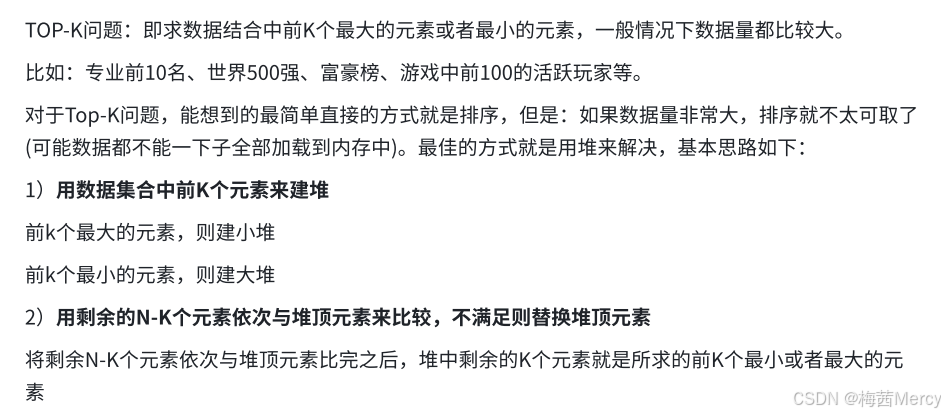一.Top-K问题

#include<stdio.h>
//先自主创建n个数据
void CreateNDate()
{
// 造数据
int n = 100000;
srand(time(0));//表示随时间初始化随机生成数的种子
const char* file = "data.txt";///创建一个文件
FILE* fin = fopen(file, "w");//“只写”写入创建的数据
if (fin == NULL)
{
perror("fopen error");
return;
}
for (int i = 0; i < n; ++i)
{
int x = (rand() + i) % 1000000;//生成n个100000以内的数据
fprintf(fin, "%d\n", x);//写入文件
}
fclose(fin);//关闭文件
}
void topk()
{
printf("请输⼊k:>");
int k = 0;
scanf("%d", &k);
const char* file = "data.txt";
FILE* fout = fopen(file, "r");//只读条件下从文件内读取数据
if (fout == NULL)
{
perror("fopen error");
return;
}
int val = 0;
int* minheap = (int*)malloc(sizeof(int) * k);
if (minheap == NULL)
{
perror("malloc error");
return;
}
for (int i = 0; i < k; i++)
{
fscanf(fout, "%d", &minheap[i]);//先在动态申请的数组里暂时插入k个数据
}
// 建k个数据的⼩堆
for (int i = (k - 1 - 1) / 2; i >= 0; i--)
{
AdjustDown(minheap, k, i);//向下调整算法,
}
int x = 0;
while (fscanf(fout, "%d", &x) != EOF)
{
// 读取剩余数据,⽐堆顶的值⼤,就替换他进堆
if (x > minheap[0])
{
minheap[0] = x;
AdjustDown(minheap, k, 0);
}
}
for (int i = 0; i < k; i++)
{
printf("%d ", minheap[i]);
}
fclose(fout);
}
//向下调整算法(具体函数内部结构参数可以参考我上一篇文章,即二叉树的数组结构)
void AdjustDown(HP* hp, int parent, int n)//n是向下调整的下界范围
{
int child = parent * 2 + 1;//公式
while (child < n)
{
//建小根堆
if (child + 1 < n && hp->arr[child + 1] < hp->arr[child])//child+1的目的是确保两个孩子结点都是有意义的结点
{
child++;
}
if (hp->arr[parent] > hp->arr[child])
{
swap(&hp->arr[parent], &hp->arr[child]);
parent = child;
child = parent * 2 + 1;
}
else
{
//我最小的孩子都比父节点大,那么这个堆就是正常堆了,直接退出
break;
}
}
}

